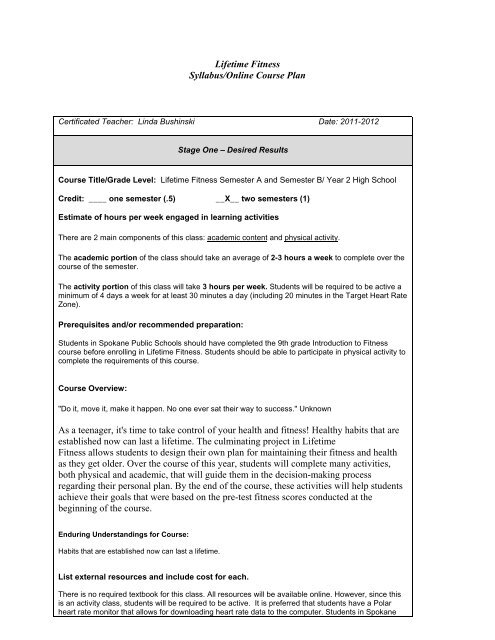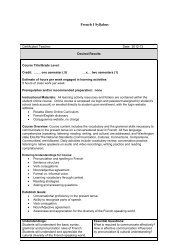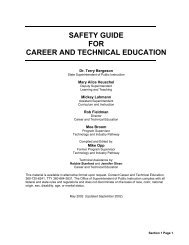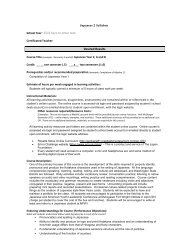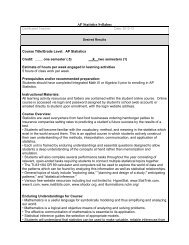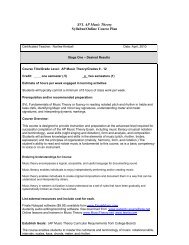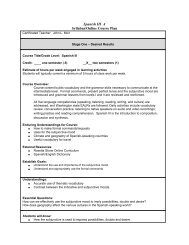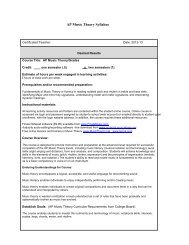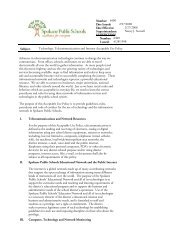Lifetime Fitness Syllabus/Online Course Plan As a teenager, it's time ...
Lifetime Fitness Syllabus/Online Course Plan As a teenager, it's time ...
Lifetime Fitness Syllabus/Online Course Plan As a teenager, it's time ...
You also want an ePaper? Increase the reach of your titles
YUMPU automatically turns print PDFs into web optimized ePapers that Google loves.
<strong>Life<strong>time</strong></strong> <strong>Fitness</strong><strong>Syllabus</strong>/<strong>Online</strong> <strong>Course</strong> <strong>Plan</strong>Certificated Teacher: Linda Bushinski Date: 2011-2012Stage One – Desired Results<strong>Course</strong> Title/Grade Level: <strong>Life<strong>time</strong></strong> <strong>Fitness</strong> Semester A and Semester B/ Year 2 High SchoolCredit: ____ one semester (.5) __X__ two semesters (1)Estimate of hours per week engaged in learning activitiesThere are 2 main components of this class: academic content and physical activity.The academic portion of the class should take an average of 2-3 hours a week to complete over thecourse of the semester.The activity portion of this class will take 3 hours per week. Students will be required to be active aminimum of 4 days a week for at least 30 minutes a day (including 20 minutes in the Target Heart RateZone).Prerequisites and/or recommended preparation:Students in Spokane Public Schools should have completed the 9th grade Introduction to <strong>Fitness</strong>course before enrolling in <strong>Life<strong>time</strong></strong> <strong>Fitness</strong>. Students should be able to participate in physical activity tocomplete the requirements of this course.<strong>Course</strong> Overview:"Do it, move it, make it happen. No one ever sat their way to success." Unknown<strong>As</strong> a <strong>teenager</strong>, <strong>it's</strong> <strong>time</strong> to take control of your health and fitness! Healthy habits that areestablished now can last a life<strong>time</strong>. The culminating project in <strong>Life<strong>time</strong></strong><strong>Fitness</strong> allows students to design their own plan for maintaining their fitness and healthas they get older. Over the course of this year, students will complete many activities,both physical and academic, that will guide them in the decision-making processregarding their personal plan. By the end of the course, these activities will help studentsachieve their goals that were based on the pre-test fitness scores conducted at thebeginning of the course.Enduring Understandings for <strong>Course</strong>:Habits that are established now can last a life<strong>time</strong>.List external resources and include cost for each.There is no required textbook for this class. All resources will be available online. However, since thisis an activity class, students will be required to be active. It is preferred that students have a Polarheart rate monitor that allows for downloading heart rate data to the computer. Students in Spokane
Public Schools may check out a heart rate monitor through their High School Health and <strong>Fitness</strong>department. However, they must agree to replace it if it is lost or broken, as stated in the <strong>Life<strong>time</strong></strong><strong>Fitness</strong> Contract in the menu on your course homepage.If use of the heart rate monitor is not possible (and it is agreed upon with the instructor), students mayuse a high quality pedometer.Students from districts other than Spokane Public Schools will have to discuss options with an SVLAdministrator and/or SVL <strong>Life<strong>time</strong></strong> <strong>Fitness</strong> Teacher.Establish Goals:Students will be able to:1. Develop fundamental and complex movement skills as developmentally appropriate.2. Understand the concepts of health-related physical fitness and develop and monitorprogress on personal fitness goals.3. Understand the relationship of nutrition and nutrients to physical performance and bodycomposition.4. Safely participate in a variety of developmentally appropriate physical activities.5. Understand patterns of growth and development.6. Acquire skills to live safely and reduce health risks.7. Gather and analyze health information.8. Use social skills to promote health and safety in a variety of situations.9. Understand how emotions influence decision-making.10. Analyze health and safety information.Understandings:To measure improvement, it is important toknow the starting point.Understanding the obesity problem in the USwill help us understand the importance ofphysical activity.Sleep, activity, and nutrition habits affectphysical and mental well being.Understanding family health history can reducethe risk of disease.Personal and environmental barriers can beovercome.Community resources can help individuals meetpersonal goals.Understanding what a job entails can lead tomaking better choices.Essential Questions:What are your fitness levels in the fivecomponent of fitness?What are your current activity levels?How much sleep do you get?Why should we exercise?What are the benefits of being active?Why is sleep important?What are the recommendations for a healthydiet?Why is family health history important?What is your family health history?What are barriers to exercise?How can you overcome these barriers?What opportunities are available for you to beactive in your community?What are the fitness/nutritional demandsof your chosen career?What are some of the stressors of the career?
Students will know:Current fitness, activity, sleep and nutritional levels/habitsThe importance of physical activity, sleep, and proper nutritionFamily health historyBarriers to exerciseCommunity resources for activity<strong>Fitness</strong> demands, stressors, and nutritional needs of chosen careersStudents will be able to:Analyze and improve fitness, activity, sleep and nutritional levels/habitsAnalyze and use family health history to reduce risk of diseaseOvercome barriers to exerciseAnalyze community resources for activityAnalyze fitness demands, stressors, and nutritional needs of chosen careersCreate a life<strong>time</strong> fitness planStage Two – Evidence of <strong>As</strong>sessmentWhat evidence will be collected to determine whether or not the understandings have been developed, the knowledge andskill attained, and the state standards met? [Anchor the work in performance tasks that involve application, supplementedas needed by prompted work, quizzes, observations, etc.]Performance Tasks:Heart Rate Monitor Data10 th Grade Final <strong>Fitness</strong> <strong>Plan</strong>Other Evidence (self-assessments, observations, work samples, quizzes, tests and so on):<strong>Fitness</strong> testsActivity Log/Activity Log AnalysisSleep Log/ Sleep Log AnalysisNutrition Log/Nutrition Log AnalysisJournal EntriesBarriers SurveyIdentification of community resourcesDiscussion BoardsCareer Choice Exploration/ Analysis10 th Grade ProjectStage Three – Learning <strong>Plan</strong>Learning Activities:XDirect InstructionIndirectInstructionExperientialLearningIndependent StudyInteractiveInstruction
___X_StructuredOverview__X__Minipresentation____Drill & Practice____Demonstrations____Other (List)____Problem-based___Case Studies____Inquiry_X___ReflectivePractice__X__Project____Paper____ConceptMapping____Other (List)____ Virt. FieldTrip____Experiments____Simulations____Games____FieldObserv.___Role-playing____Model Bldg.____Surveys____Other (List)____Essays_X__Self-pacedcomputer_X___Journals____Learning Logs____Reports____Directed Study____ResearchProjects____Other (List)__X__Discussion____Debates___Role Playing____Panels____Peer PartnerLearning____Project team____Laboratory Groups____Think, Pair, Share____CooperativeLearning____Tutorial Groups__X__Interviewing____Conferencing____Other (List)Scope and Sequence:The following topics will be covered during the first semester of this course, Semester A <strong>Life<strong>time</strong></strong><strong>Fitness</strong>. Students will be required to collect, analyze and apply the information explored in each unit.Unit 1: Getting StartedReview- Components of <strong>Fitness</strong>Current <strong>Fitness</strong> Level- <strong>Fitness</strong> Pre-testGoal SettingCurrent Activity Level- Activity LogSleep LogUnit 2: A Case for <strong>Fitness</strong>A Case for <strong>Fitness</strong>Obesity Trends in the U.S.A Physically Education PersonUnit 3: Nutritional HabitsPortion DistortionNutritional HabitsFood MarketingUnit 4: Family Genetics, Current Health IssuesFamily Health HistoryYour Family TreeUnit 5: Post-<strong>Fitness</strong> TestingPost-fitness Test
The following topics will be covered during the second semester of this course, Semester B <strong>Life<strong>time</strong></strong><strong>Fitness</strong>. Students will be required to collect, analyze and apply the information explored in each unit.Unit 1: Getting StartedReview- Components of <strong>Fitness</strong>Current <strong>Fitness</strong> Level- <strong>Fitness</strong> Pre-testGoal SettingCurrent Activity Level- Activity LogUnit 5: Environmental Barriers to ExerciseEnvironmental Barriers SurveyOvercoming Environmental BarriersUnit 6: Community Resource ExplorationCommunity Resource ExplorationCommunity Resource AnalysisUnit 7: Health and <strong>Fitness</strong> requirements for Career ChoicesOccupation Table and worksheetUnit 8: Comprehensive <strong>Fitness</strong> and Health <strong>Plan</strong>Post-fitness Testing<strong>Fitness</strong> and Health Project10th Grade <strong>Fitness</strong> <strong>Plan</strong>Adapted from Understanding by Design Template available online and the Understanding by Design: Professional Development Workbook.References:Wiggins, G., & McTighe, J. (n.d.). Understanding by Design Exchange. Retrieved November 2, 2004 from http://www.ubdexchange.org/Wiggins, G., & McTighe, J. (2004). Understanding by design: Professional development workbook. Alexandria, VA: <strong>As</strong>sociation for Supervision andCurriculum Development.)


